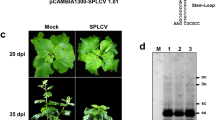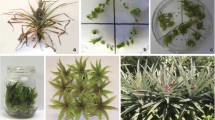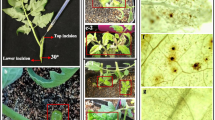Abstract
Sugarcane streak mosaic virus (SStMV), an unassigned member of the family Potyviridae, is an emerging cause of sugarcane mosaic disease in Asia. SStMV-free sugarcane was generated from infected plants by in vitro meristem tip culture technology. Meristem-tip explants regenerated satisfactorily when treated with a solution of anti-necrotic compounds (combination of ascorbic acid, cystine hydrochloride and silver nitrate) before culture initiation. None of the plants that generated from meristem tips showed visible mosaic symptoms even after 12 months of cultivation. When indexed by bioassay on Sorghum bicolor cv. Rio and direct antigen coating-ELISA (DAC-ELISA), all of the regenerated plants were negative for SStMV infection. When tested by immunocapture-reverse transcription-PCR (IC-RT-PCR), ~92% of the micropropagated plants were SStMV-free and the remaining plants found to be positive for SStMV infections. This confirms the higher sensitivity of IC-RT-PCR over bioassay and DAC-ELISA. In vitro meristem tip culture in combination with sensitive molecular detection tests appears to be a rapid and reliable approach for generation of SStMV-free sugarcane planting material from infected sugarcane germplasm.



Similar content being viewed by others
References
Balamuralikrishnan, M., Doraisamy, S., Ganapathy, T., & Viswanathan, R. (2003). Impact of serial thermotherapy on Sugarcane mosaic virus titre and regeneration in sugarcane. Archives of Phytopathology and Plant Protection, 36, 173–178.
Candresse, T., Hammond, R. W., & Hadidi, A. (1998). Detection and identification of plant viruses and viroids using polymerase chain reaction (PCR). In A. Hadidi, R. K. Ketharpal, & H. Koganezawa (Eds.), Plant virus disease control (pp. 399–416). Minnesota: APS.
Chatenet, M., Delage, C., Ripolles, M., Irey, M., Lockhart, B. E. L., & Rott, P. (2001). Detection of Sugarcane yellow leaf virus in quarantine and production of virus-free sugarcane by apical meristem culture. Plant Disease, 85, 1177–1180.
Clark, M. F., & Bar-Joseph, M. (1984). Enzyme immunosorbent assays in plant virology. In K. Maramorosch & H. Koprowski (Eds.), Methods in virology (pp. 51–85). New York: Academic.
Dean, J. L. (1982). Failure of Sugarcane mosaic virus to survive in cultured sugarcane tissue. Plant Disease Reporter, 66, 1060–1061.
Dovas, I. C., Hatziloucas, E., Salomon, R., Barg, E., Shiboleth, Y., & Katis, N. I. (2001). Comparison of methods for virus detection in allium spp. Journal of Phytopathology, 149, 731–737.
Enriquez-Obregon, G. A., Vazquez-Padron, R. I., Prieto-Samsonov, D. L., Marlene Perez, M., & Selman-Housein, G. (1997). Genetic transformation of sugarcane by Agrobacterium tumefaciens using antioxidant compounds. Biotecnologia Aplicada, 14, 169–174.
Faccioli, G., & Marani, F. (1998). Virus elimination by meristem culture and tip micrografting. In A. Hadidi, R. K. Ketharpal, & H. Koganezawa (Eds.), Plant virus disease control (pp. 346–380). Minnesota: APS.
Fitch, M. M. M., Lehrer, A. T., Komor, E., & Moore, P. H. (2001). Elimination of Sugarcane yellow leaf virus from infected sugarcane plants by meristem tip culture visualized by tissue blot immunoassay. Plant Pathology, 50, 676–680.
Garcia, R., Cidade, D., Castellar, A., Andrea-Lips, A., Magioli, C., Callado, C., et al. (2007). In vitro morphogenesis patterns from shoot apices of sugarcane are determined by light and type of growth regulator. Plant Cell, Tissue and Organ Culture, 90, 181–190.
Hema, M., Kirthi, N., Sreenivasulu, P., & Savithri, H. S. (2003). Development of recombinant coat protein antibody based IC-RT-PCR for detection and discrimination of sugarcane streak mosaic virus isolates from Southern India. Archives of Virology, 148, 1185–1193.
Hema, M., Subba-Reddy, Ch V, Savithri, H. S., & Sreenivasulu, P. (2008). Sugarcane streak mosaic virus. In G. P. Rao, S. M. Paul-Khurana, & S. L. Lenardon (Eds.), Characterization, diagnosis and management of plant viruses; vol. I. industrial crops (pp. 145–168). Texas: Studium.
Hendre, R. R., Mascarenhas, A. F., Nadgir, A. L., Pathak, M., & Jagannathan, V. (1975). Growth of mosaic virus-free sugarcane plants from apical meristems. Indian Phytopathology, 28, 175–178.
Hull, R. (2002). Matthews’ plant virology (p. 1001). California: Academic.
Lee, T. S. G. (1987). Micropropagation of sugarcane (Saccharum spp.). Plant Cell, Tissue and Organ Culture, 10, 47–55.
Leu, L. S. (1972). Freeing sugarcane from mosaic virus by apical meristem and tissue culture. Taiwan Sugar Experiment Station Report, 57, 57–63.
Martin, R. R. (1998). Advanced diagnostic tools as an aid to controlling plant virus diseases. In A. Hadidi, R. K. Ketharpal, & H. Koganezawa (Eds.), Plant virus disease control (pp. 381–391). Minnesota: APS.
Murashige, T., & Skoog, F. (1962). A revised medium for rapid growth and bioassays with tobacco tissue cultures. Physiologia Plantarum, 15, 473–497.
Parmessur, Y., Aljanabi, S., Saumtally, S., & Dookun-Saumtally, A. (2002). Sugarcane yellow leaf virus and Sugarcane yellows phytoplasma: Elimination by tissue culture. Plant Pathology, 51, 561–566.
Rao, G. P., Singh, M., Gaur, R. K., & Jain, R. K. (2004). Antigenic and biological diversity among Sugarcane mosaic virus isolates from different geographical regions in India. Indian Journal of Biotechnology, 3, 538–541.
Sambrook, J., & Russel, D. W. (2001). Molecular cloning, a laboratory manual, vol. I. New York: Cold Spring Harbor Laboratory.
Saumtally, S., Dhayan, S., Ganoo, S., & Sullivan, S. (1995). Disease constraints associated with the movement of sugarcane germplasm to and from Mauritius. In B. J. Croft (Ed.), Sugarcane germplasm conservation and exchange: Report of an international workshop (pp. 42–45). Queensland: ACIAR.
Shukla, D. D., & Ward, C. W. (1989). Identification and classification of potyviruses on the basis of coat protein sequence data and serology. Archives of Virology, 106, 171–200.
Viswanathan, R., Balamuralikrishnan, M., & Karuppaiah, R. (2008). Characterization and genetic diversity of Sugarcane streak mosaic virus-causing mosaic in sugarcane. Virus Genes, 36, 553–564.
Viswanathan, R., Karuppaiah, R., & Balamuralikrishnan, M. (2010). Detection of three major RNA viruses infecting sugarcane by multiplex reverse transcription-polymerase chain reaction (multiplex-RT-PCR). Australasian Plant Pathology, 39, 79–84.
Wagih, M. E., Gordon, G. H., Ryan, C. C., & Adkins, S. W. (1995). Development of an axillary bud culture technique for Fiji disease virus elimination in sugarcane. Australian Journal of Botany, 43, 135–143.
Acknowledgements
The authors thank Dr. G. Sekhar, Principal Scientist, Agricultural Research Station of Acharya N. G. Ranga Agricultural University, Perumallapalle-517 505, Chittoor district, Andhra Pradesh for providing healthy sugarcane.
Author information
Authors and Affiliations
Corresponding author
Rights and permissions
About this article
Cite this article
Ch. V., S.R., P., S. Generation of Sugarcane streak mosaic virus-free sugarcane (Saccharum spp. hybrid) from infected plants by in vitro meristem tip culture. Eur J Plant Pathol 130, 597–604 (2011). https://doi.org/10.1007/s10658-011-9781-7
Accepted:
Published:
Issue Date:
DOI: https://doi.org/10.1007/s10658-011-9781-7




